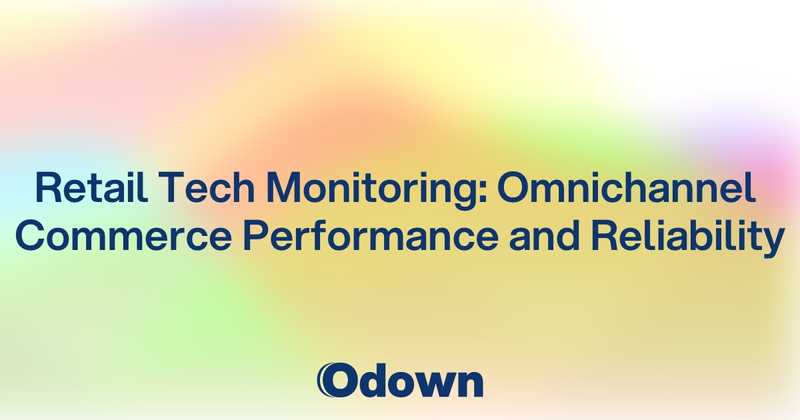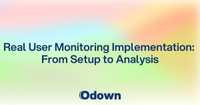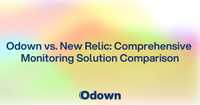Retail Tech Monitoring: Omnichannel Commerce Performance and Reliability
Your retail empire spans hundreds of physical stores, a thriving e-commerce site, and a popular mobile app. Your monitoring shows everything running smoothly across all systems. Then Black Friday arrives and your carefully orchestrated omnichannel strategy crumbles. Online inventory shows products available that stores sold hours ago. Mobile app customers can't find items that are sitting on store shelves. Buy-online-pickup-in-store orders disappear into a black hole between your digital and physical systems.
The technical infrastructure was stable, but the complex integrations that make omnichannel retail possible failed under pressure. Inventory synchronization worked fine during normal traffic but couldn't handle holiday volumes. Customer data platforms tracked online behavior perfectly but couldn't correlate it with in-store purchases. Your monitoring focused on individual system health but missed the orchestration failures that broke the seamless customer experience you promised.
Retail technology monitoring requires understanding that modern customers don't see channels - they see brands. When inventory, pricing, or customer data differs between channels, customers lose trust. When systems can't coordinate fulfillment across channels, retailers lose sales and operational efficiency. Retail monitoring must ensure that complex technology ecosystems work together seamlessly to deliver unified customer experiences.
Omnichannel Commerce Monitoring: Online, Mobile, and In-Store Integration
Omnichannel retail requires monitoring that tracks performance across all customer touchpoints while ensuring data consistency and workflow integration.
Cross-Channel Customer Experience
Omnichannel monitoring must track how customers move between different channels and ensure consistent experiences regardless of how customers choose to interact with your brand.
Customer journey tracking monitoring traces individual customers as they research online, visit stores, use mobile apps, and complete purchases across multiple touchpoints.
Cross-channel cart synchronization monitoring ensures that products added to carts in one channel remain available when customers switch to different channels.
Pricing consistency monitoring tracks how product pricing displays across different channels and identifies discrepancies that might confuse customers or create competitive disadvantages.
Promotion synchronization monitoring ensures that sales, discounts, and special offers apply consistently across all channels according to business rules.
Customer service integration monitoring tracks how customer support can access complete customer interaction history regardless of which channels customers have used.
Buy Online, Pick Up In Store (BOPIS) Operations
BOPIS fulfillment requires coordination between online systems and physical store operations that traditional e-commerce monitoring doesn't address.
BOPIS order routing monitoring tracks how online orders are assigned to appropriate store locations based on inventory availability and customer preferences.
Store fulfillment monitoring tracks how in-store staff receive, prepare, and manage online orders for customer pickup.
Customer notification monitoring tracks pickup-ready alerts and ensures customers receive timely notifications when orders are available for collection.
Pickup process monitoring tracks the in-store customer experience for order collection and identifies bottlenecks that might create customer frustration.
BOPIS inventory reservation monitoring ensures that items ordered online remain available for pickup and don't get sold to in-store customers before pickup completion.
Ship-from-Store and Distributed Fulfillment
Modern retail often uses store inventory to fulfill online orders, requiring monitoring that tracks distributed fulfillment operations.
Ship-from-store order routing monitoring tracks how online orders are assigned to store locations that can fulfill shipping requirements efficiently.
Store shipping capacity monitoring tracks how many online orders individual stores can process without affecting in-store customer service.
Shipping integration monitoring tracks how stores connect with shipping carriers and generate tracking information for online orders.
Return-to-store monitoring tracks how online returns are processed in physical stores and how returned inventory is handled across channels.
Digital and Physical Integration
Omnichannel retail requires integration between digital systems and physical store operations that creates unique monitoring requirements.
In-store digital experience monitoring tracks how mobile apps, digital signage, and interactive displays function in physical store environments.
Staff device monitoring tracks tablets, mobile scanners, and other technology that store employees use to serve customers and access inventory information.
WiFi and connectivity monitoring ensures that in-store digital experiences have reliable network connectivity for customer and staff use.
Point-of-sale integration monitoring tracks how in-store transactions integrate with customer profiles and omnichannel analytics.
Inventory Management System Monitoring Across Channels
Retail inventory management requires real-time accuracy across multiple channels and fulfillment methods to prevent overselling and stockouts.
Real-Time Inventory Synchronization
Inventory accuracy is critical for omnichannel retail because customers expect consistent availability information regardless of how they access your brand.
Cross-channel inventory sync monitoring tracks how inventory updates propagate between online systems, mobile apps, and in-store point-of-sale systems.
Inventory reservation monitoring tracks how products are held for customers during checkout processes across different channels.
Back-order and pre-order monitoring tracks special inventory situations and ensures that customer expectations are managed appropriately across all channels.
Inventory allocation monitoring tracks how available inventory is distributed between different channels and fulfillment methods.
Stock level accuracy monitoring compares system inventory records with actual physical inventory to identify discrepancies that affect customer experience.
Multi-Location Inventory Management
Retail chains require inventory monitoring that provides visibility across hundreds or thousands of store locations and distribution centers.
Store-level inventory monitoring tracks product availability at individual store locations and identifies stores with inventory imbalances.
Distribution center monitoring tracks warehouse inventory levels and shipping capacity that affects online order fulfillment.
Transfer monitoring tracks inventory movement between stores and warehouses to optimize stock levels and reduce stockouts.
Seasonal inventory monitoring tracks how seasonal demand patterns affect inventory levels and identifies optimization opportunities.
Demand forecasting integration monitoring tracks how inventory planning systems use sales data and analytics to optimize purchasing and allocation decisions.
Supplier and Vendor Integration
Retail inventory systems integrate with numerous suppliers and vendors that require monitoring to ensure supply chain reliability.
EDI (Electronic Data Interchange) monitoring tracks automated ordering and inventory updates with suppliers and ensures reliable data exchange.
Drop-shipping integration monitoring tracks vendor fulfillment for products that ship directly from suppliers to customers.
Purchase order monitoring tracks order placement with suppliers and ensures timely delivery to maintain inventory levels.
Vendor performance monitoring tracks supplier delivery times, quality metrics, and reliability that affects inventory planning.
Inventory Analytics and Optimization
Inventory monitoring should provide insights that support business decisions about purchasing, pricing, and product assortment.
Inventory turnover monitoring tracks how quickly products sell and identifies slow-moving inventory that might require markdowns or promotional activities.
Stockout monitoring tracks out-of-stock situations and identifies patterns that might indicate systematic inventory management issues.
Markdown optimization monitoring tracks how price reductions affect inventory movement and profitability.
Product performance monitoring tracks sales velocity across different channels and identifies products that perform better in specific channels.
Customer Data Platform (CDP) Monitoring for Retail Personalization
Retail personalization requires comprehensive customer data platforms that unify customer information across all touchpoints and channels.
Customer Data Integration and Quality
CDP monitoring must ensure that customer data from all channels integrates accurately to provide unified customer profiles.
Data ingestion monitoring tracks how customer data flows from point-of-sale systems, e-commerce platforms, mobile apps, and other touchpoints into centralized customer profiles.
Identity resolution monitoring tracks how the platform identifies and connects customer interactions across different channels and devices.
Data quality monitoring tracks accuracy, completeness, and freshness of customer data that affects personalization effectiveness.
Privacy compliance monitoring ensures that customer data collection and usage comply with GDPR, CCPA, and other privacy regulations.
Data governance monitoring tracks how customer data is managed, secured, and accessed according to corporate policies and regulatory requirements.
Real-Time Personalization and Recommendations
Retail personalization requires real-time processing of customer data to deliver relevant experiences across all channels.
Recommendation engine monitoring tracks how product suggestions are generated and delivered across different channels and touchpoints.
Dynamic content monitoring tracks how personalized content displays on websites, mobile apps, and digital signage based on customer profiles.
Behavioral targeting monitoring tracks how customer actions trigger personalized marketing messages and product recommendations.
Cross-sell and upsell monitoring tracks how personalization affects additional purchase opportunities and revenue per customer.
A/B testing integration monitoring tracks how personalization experiments affect customer behavior and business metrics.
Customer Segmentation and Analytics
CDP monitoring should track how customer segmentation affects marketing effectiveness and business outcomes.
Segment performance monitoring tracks how different customer segments respond to marketing campaigns and personalization efforts.
Lifecycle stage monitoring tracks how customers progress through different relationship stages and how technology supports customer development.
Churn prediction monitoring tracks early warning indicators that identify customers at risk of leaving and enables proactive retention efforts.
Customer lifetime value monitoring tracks how personalization and customer experience improvements affect long-term customer value.
Marketing Automation Integration
CDPs integrate with marketing automation platforms that require monitoring to ensure effective campaign execution.
Email campaign monitoring tracks how customer data drives personalized email marketing and measures campaign effectiveness.
Social media integration monitoring tracks how customer profiles enhance social media advertising and audience targeting.
Marketing attribution monitoring tracks how different marketing touchpoints contribute to customer conversion and purchase decisions.
Campaign performance monitoring tracks how customer data quality affects marketing campaign effectiveness and ROI.
Retail Analytics and Business Intelligence Monitoring
Retail analytics systems process vast amounts of data from multiple sources to provide insights that drive business decisions.
Sales and Performance Analytics
Retail analytics must provide real-time visibility into business performance across all channels and product categories.
Sales performance monitoring tracks revenue, transaction volumes, and conversion rates across different channels and time periods.
Product performance monitoring tracks sales by SKU, category, and brand to identify trends and optimization opportunities.
Store performance monitoring tracks individual location performance and identifies best practices that can be scaled across the retail network.
Channel performance monitoring tracks how different sales channels contribute to overall business performance and customer acquisition.
Customer Analytics and Insights
Customer analytics help retailers understand shopping behavior and optimize customer experiences across all touchpoints.
Customer behavior analytics monitoring tracks shopping patterns, preferences, and trends that inform business strategy.
Purchase analytics monitoring tracks buying patterns and identifies opportunities for product recommendations and cross-selling.
Customer satisfaction monitoring tracks Net Promoter Scores, reviews, and feedback across all channels.
Return and refund analytics monitoring tracks product return patterns and identifies quality issues or customer satisfaction problems.
Operational Analytics
Retail operations generate enormous amounts of data that require monitoring to ensure business efficiency and optimization.
Supply chain analytics monitoring tracks vendor performance, delivery times, and cost optimization opportunities.
Staffing analytics monitoring tracks employee productivity, scheduling efficiency, and training needs across retail locations.
Loss prevention analytics monitoring tracks shrinkage, theft patterns, and security effectiveness across retail locations.
Energy and facilities monitoring tracks operational costs and identifies efficiency opportunities across retail real estate.
Financial and Profitability Analytics
Retail financial analytics must provide insights into profitability and financial performance across complex business operations.
Margin analysis monitoring tracks profitability by product, category, channel, and customer segment.
Cost analytics monitoring tracks operational expenses and identifies cost reduction opportunities.
Pricing analytics monitoring tracks how pricing strategies affect sales volume and profitability.
Financial reporting monitoring tracks how operational data flows into financial systems for accounting and regulatory reporting.
Retail technology monitoring transforms complex omnichannel operations into transparent, optimized customer experiences that drive business growth. Instead of managing channels independently, you get unified visibility into the technology ecosystem that enables seamless customer experiences and operational efficiency.
The investment in comprehensive retail tech monitoring pays dividends in improved customer satisfaction, reduced operational costs, and data-driven insights that support strategic business decisions. You finally get the visibility needed to coordinate complex retail ecosystems that span digital and physical touchpoints.
Ready to implement comprehensive retail tech monitoring? Odown provides omnichannel-aware monitoring that tracks customer journeys, inventory synchronization, and system integration alongside traditional uptime monitoring. Combined with our food tech monitoring expertise, you'll have monitoring strategies that work for both complex logistics operations and customer-facing retail experiences that require seamless coordination across multiple systems and channels.



